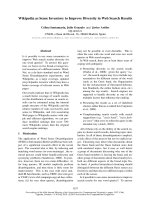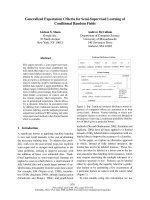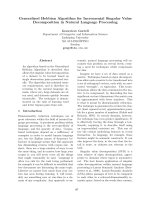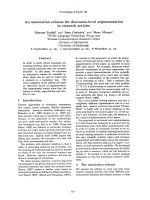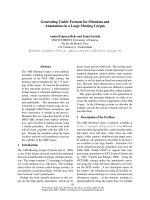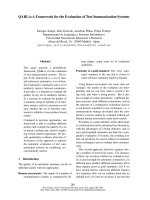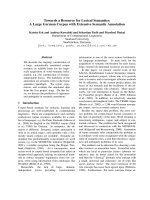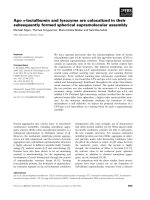Báo cáo khoa học: "On2L - A Framework for Incremental Ontology Learning in Spoken Dialog Systems" doc
Bạn đang xem bản rút gọn của tài liệu. Xem và tải ngay bản đầy đủ của tài liệu tại đây (173.33 KB, 6 trang )
Proceedings of the COLING/ACL 2006 Student Research Workshop, pages 61–66,
Sydney, July 2006.
c
2006 Association for Computational Linguistics
On2L - A Framework for Incremental Ontology Learning in Spoken
Dialog Systems
Berenike Loos
European Media Laboratory GmbH
Schloss-Wolfsbrunnenweg 33
69118 Heidelberg, Germany
Abstract
An open-domain spoken dialog system has
to deal with the challenge of lacking lexi-
cal as well as conceptual knowledge. As
the real world is constantly changing, it is
not possible to store all necessary knowl-
edge beforehand. Therefore, this knowl-
edge has to be acquired during the run
time of the system, with the help of the
out-of-vocabulary information of a speech
recognizer. As every word can have var-
ious meanings depending on the context
in which it is uttered, additional context
information is taken into account, when
searching for the meaning of such a word.
In this paper, I will present the incremental
ontology learning framework On2L. The
defined tasks for the framework are: the
hypernym extraction from Internet texts
for unknown terms delivered by the speech
recognizer; the mapping of those and their
hypernyms into ontological concepts and
instances; and the following integration of
them into the system’s ontology.
1 Introduction
A computer system, which has to understand and
generate natural language, needs knowledge about
the real world. As the manual modeling and main-
tenance of those knowledge structures, i.e. ontolo-
gies, are both time and cost consuming, there ex-
ists a demand to build and populate them automat-
ically or at least semi automatically. This is possi-
ble by analyzing unstructured, semi-structured or
fully structured data by various linguistic as well
as statistical means and by converting the results
into an ontological form.
In an open-domain spoken dialog system the au-
tomatic learning of ontological concepts and cor-
responding relations between them is essential,
as a complete manual modeling of them is nei-
ther practicable nor feasible as the real world and
its objects, models and processes are constantly
changing and so are their denotations.
This work assumes that a viable approach to
this challenging problem is to learn ontological
concepts and relations relevant for a certain user
- and only those - incrementally, i.e. at the time
of the user’s inquiry. Hypernyms
1
of terms that
are not part of the speech recognizer lexicon, i.e.
out-of-vocabulary (OOV) terms, and hence lack-
ing any mapping to the employed knowledge rep-
resentation of the language understanding compo-
nent, should be found in texts from the Internet.
That is the starting point of the proposed ontol-
ogy learning framework On2L (On-line Ontology
Learning). With the found hypernym On2L can
assign the place in the system’s ontology to add
the unknown term.
So far the work described herein refers to the
German language only. In a later step, the goal is
to optimize it for English as well.
2 Natural Language and Ontology
Learning
Before describing the actual ontology learning
process it is important to make a clear distinction
between the two fields involved: this is on the one
hand natural language and on the other hand onto-
logical knowledge.
As the Internet is a vast resource of up-to-date
1
According to Lyons (1977) hyponymy is the relation
which holds between a more specific lexeme (i.e. a hyponym)
and a more general one (i.e. a hypernym). E.g. animal is a
hypernym of cat.
61
information, On2L employs it to search for OOV
terms and their corresponding hypernyms. The
natural language texts are rich in terms, which can
be used as labels of concepts in the ontology and
rich in semantic relations, which can be used as
ontological relations.
The two areas which are working on similar
topics but are using different terminology need
to be distinguished, so that the extraction of se-
mantic information from natural language is sep-
arated from the process of integrating this knowl-
edge into an ontology.
Figure 1: Natural Language and Ontology Learn-
ing
Figure 1 shows the process of ontology learning
from natural language text. On the left side natural
language lexemes are extracted. During a transfor-
mation process nouns, verbs and proper nouns are
converted into concepts, relations and instances of
an ontology
2
.
3 Related Work
The idea of acquiring knowledge exactly at the
time it is needed is new and became extremely
useful with the emergence of open-domain dia-
log systems. Before that, more or less complete
ontologies could be modeled for the few domains
covered by a dialog system. Nonetheless, many
ontology learning frameworks exist, which alle-
viate the work of an ontology engineer to con-
struct knowledge manually, e.g. ASIUM (Faure
and Nedellec, 1999), which helps an expert in ac-
quiring knowledge from technical text using syn-
tactic analysis for the extraction, a semantic simi-
larity measure and a clustering algorithm for the
2
In our definition of the term ontology not only concepts
and relations are included but also instances of the real world.
conceptualization. OntoLearn (Missikoff et al.,
2002) uses specialized web site texts as a corpus
to extract terminology, which is filtered by statis-
tical techniques and then used to create a domain
concept forest with the help of a semantic interpre-
tation and the detection of taxonomic and similar-
ity relations. KAON Text-To-Onto (Maedche and
Staab, 2004) applies text mining algorithms for
English and German texts to semi-automatically
create an ontology, which includes algorithms for
term extraction, for concept association extraction
and for ontology pruning.
Pattern-based approaches to extract hy-
ponym/hypernym relationships range from
hand-crafted lexico-syntactic patterns (Hearst,
1992) to the automatic discovery of such patterns
by e.g. a minimal edit distance algorithm (Pantel
et al., 2004).
The SmartWeb Project into which On2L will be
integrated as well, aims at constructing an open-
domain spoken dialog system (Wahlster, 2004)
and includes different techniques to learn ontolog-
ical knowledge for the system’s ontology. Those
methods work offline and not at the time of the
user’s inquiry in contrast to On2L:
C-PANKOW (Cimiano et al., 2005) puts a
named entity into several linguistic patterns that
convey competing semantic meanings. The pat-
terns, which can be matched most often on the web
indicate the meaning of the named entity.
RelExt (Schutz and Buitelaar, 2005) automat-
ically identifies highly relevant pairs of concepts
connected by a relation over concepts from an
existing ontology. It works by extracting verbs
and their grammatical arguments from a domain-
specific text collection and computing correspond-
ing relations through a combination of linguistic
and statistical processing.
4 The ontology learning framework
The task of the ontology learning framework
On2L is to acquire knowledge at run time. As
On2L will be integrated into the open-domain di-
alog system Smartweb (Wahlster, 2004), it will be
not only useful for extending the ontology of the
system, but to make the dialog more natural and
therefore user-friendly.
Natural language utterances processed by an
open-domain spoken dialog system may contain
words or parts of words which are not recognized
by the speech recognizer, as they are not contained
62
in the recognizer lexicon. The words not contained
are most likely not represented in the word-to-
concept lexicon as well
3
. In the presented ontol-
ogy learning framework On2L the corresponding
concepts of those terms are subject to a search on
the Internet. For instance, the unknown term Auer-
stein would be searched on the Internet (with the
help of a search engine like Google). By applying
natural language patterns and statistical methods
possible hypernyms of the term can be extracted
and the corresponding concept in the ontology of
the complete dialog system can be found. This
process is described in Section 4.5.
As a term often has more than one meaning
depending on the context in which it is uttered,
some information about this context is added for
the search
4
as shown in Section 4.4.
Figure 2 shows the life cycle of the On2L frame-
work. In the middle of the diagram the question
example by a supposed user is: How do I get to
the Auerstein? The lighter fields in the figure mark
components of the dialog system, which are only
utilized by On2L, whereas the darker fields are es-
pecially built to complete the ontology learning
task.
Figure 2: The On2L Life Cycle
The sequential steps shown in Figure 2 are de-
scribed in more detail in the following paragraphs
starting with the processing of the user’s utterance
by the speech recognizer.
4.1 Speech Recognition
The speech recognizer classifies all words of the
user’s utterance not found in the lexicon as out-
3
In case the speech recognizer of the system and the word-
to-concept lexicon are consistent.
4
Of course, even in the same context a term can have more
than one meaning as discussed in Section 4.6.
of-vocabulary (OOV). That means an automatic
speech recognition (ASR) system has to process
words, which are not in the lexicon of the speech
recognizer (Klakow et al., 2004). A solution
for a phoneme-based recognition is the establish-
ment of corresponding best rated grapheme-chain
hypotheses (Gallwitz, 2002). These grapheme-
chains are constructed with the help of statistical
methods to predict the most likely grapheme order
of a word, not found in the lexicon. Those chains
are then used for a search on the Internet in the
final version of On2L. To evaluate the framework
itself adequately so far only a set of correctly writ-
ten terms is subject to search.
4.2 Language Understanding
In this step of the dialog system, all correctly
recognized terms of the user utterance are mapped
to concepts with the help of a word-to-concept lex-
icon. Such a lexicon assigns corresponding nat-
ural language terms to all concepts of an ontol-
ogy. This is not only a necessary step for the di-
alog system, but can assist the ontology learning
framework in a possibly needed semantic disam-
biguation of the OOV term.
Furthermore the information of the concepts of
the other terms of the utterance can help to evalu-
ate results: when there are more than one concept
proposal for an instance (i.e. on the linguistic side
a proper noun like Auerstein) found in the system’s
ontology, the semantic distance between each pro-
posed concept and the other concepts of the user’s
question can be calculated
5
.
4.3 Preprocessing
A statistical part-of-speech tagging method de-
cides on the most probable part-of-speech of the
whole utterance with the help of the sentence con-
text of the question. In the On2L framework
we used the language independent tagger qtag
6
,
which we trained with the hand-tagged German
corpus NEGRA 2
7
.
5
E.g. with the single-source shortest path algorithm of
Dijkstra (Cormen et al., 2001).
6
qtag exists as a downloadable JAR file and
can therefore be integrated into a platform inde-
pendent JAVA program. For more information, see
/>(last access: 21st February 2006).
7
The NEGRA corpus version 2 consists of 355,096 to-
kens (20,602 sentences) of German newspaper text, taken
from the Frankfurter Rundschau. For more information
visit: />corpus/negra-corpus.html (last access: 21st February 2006).
63
With the help of this information, the part-of-
speech of the hypernym of the OVV term can be
predicted. Furthermore, the verb(s) of the utter-
ance can anticipate possible semantic relations for
the concept or instance to be integrated into the
ontology.
4.4 Context Module
To understand the user in an open-domain dialog
system it is important to know the extra-linguistic
context of the utterances. Therefore a context
module is applied in the system, which can give
information on the discourse domain, day and
time, current weather conditions and location of
the user. This information is important for On2L
as well. Here we make use of the location of the
user and the discourse domain so far, as this infor-
mation is most fruitful for a more specific search
on the Internet. The location is delivered by a GPS
component and the discourse domain is detected
with the help of the pragmatic ontology PrOnto
((Porzel et al., 2006)). Of course, the discourse
domain can only be detected for domains modeled
already in the knowledge base (Rueggenmann and
Gurevych, 2004).
The next section will show the application of the
context terms in more detail.
4.5 Hypernym extraction from the Internet
We apply the OOV term from the speech recog-
nizer as well as a context term for the search of
the most likely hypernym on the Internet.
For testing reasons a list of possible queries was
generated. Here are some examples to give an
idea:
(1) Auerstein – Heidelberg
(2) Michael Ballack – SportsDiscourse
(3) Lord of the Rings – CinemaDiscourse
On the left side of the examples 1 to 3 is the
OOV term and on the right side the corresponding
context term as generated by the context module.
For searching, the part “Discourse” is pruned.
The reason to lay the main focus of the evalu-
ation searches on proper nouns is, that those are
most likely not in the recognizer lexicon and not
as instances in the system’s ontology.
4.5.1 Global versus Local OOVs
To optimize results we make a distinction be-
tween global OOVs and local OOVs.
In the case of generally familiar proper nouns
like stars, hotel chains or movies (so to say global
OOVs), a search on Wikipedia can be quite suc-
cessful.
In the case of proper nouns, only common in
a certain country region, like Auerstein (Restau-
rant), Bierbrezel (Pub) and Lux (Cinema), which
are local OOVs, a search with Wikipedia is gener-
ally not fruitful. Therefore it is searched with the
help of the Google API.
As one can not know the kind of OOV before-
hand, the Wikipedia search is started before the
Google search. If no results are produced, the
Google search will deliver them hopefully. If re-
sults are found, Google search will be used to test
those.
4.5.2 Wikipedia Search
The structure of Wikipedia
8
entries is preas-
signed. That means, the program can know, where
to find the most suitable information beforehand.
In the case of finding hypernyms the first sentence
in the encyclopedia description is most useful. To
give an example, here is the first sentence for the
search entry Michael Ballack:
(4) Michael Ballack (born September 26,
1976 in Grlitz, then East Germany) IS A
German football player.
With the help of lexico-syntactic patterns, the
hypernym can be extracted. Those so-called
Hearst patterns (Hearst, 1992) occur frequently in
lexicons for describing a term. In example 4 the
pattern X is a Y would be matched and the hyper-
nym football player
9
of the term Michael Ballack
could be extracted.
4.5.3 Google Search
The search parameters in the Google API can
be adjusted for the corresponding search task. The
tasks we used for our framework are a search in
the titles of the web pages and a search in the text
of the web pages.
Adjusting the Google parameters The as-
sumption was, that depending on the task the
Google parameters should be adjusted. Four pa-
rameters were tested with the two tasks (Title and
8
Wikipedia is a free encyclopedia, which is editable on
the Internet: www.wikipedia.org (last access: 22nd February
2006)
9
In German compounds generally consist of only one
word, therefore it is easier to extract them than in the case
of English ones.
64
Page Search, as described in the next paragraphs)
and a combination thereof. The parameter default
is used, when no other parameters are assigned; in-
title is set, in case the search term should be found
in the title of the returned pages; allintext, when
the search term should be found in the text of the
pages; and inurl, when the search term should be
found in the URL.
In Figure 3 the outcome of the evaluation is
shown. The evaluation was done by students, who
scored the titles and pages with 1, when a possible
hypernym could be found and 0 if not. Surpris-
ingly, the default value delivered the best results
for all tasks, followed by the allintext parameter.
Figure 3: Evaluation of the Google parameters
Title Search To search only in the titles of the
web pages has the advantage, that results can be
generated relatively fast. This is important as time
is a relevant factor in spoken dialog systems. As
the titles often contain the hypernym but do not
consist of a full sentence, Hearst patterns cannot
be found. Therefore, an algorithm was imple-
mented, which searches for nouns in the title, ex-
tracts them and counts the occurrences. The noun
most frequently found in all the titles delivered
by Google is regarded as the hypernym. For the
counting we applied stemming and clustering al-
gorithms to group similar terms.
Page Search For Page Search Hearst patterns as
in Wikipedia Search were applied. In contrast to
encyclopedia entries the recall of those patterns
was not so high in the texts from the web pages.
Thus, we searched in the text surrounding of the
searched term for nouns. Equally to Title Search
we counted the occurrence of nouns. Different
evaluation steps showed, that the window size of
four words in front and after the term is most suc-
cessful.
With the help of machine learning algorithms
from the WEKA
10
library we did a text mining to
10
(last access: 21st
ameliorate the results as shown in Faulhaber et al.
(2006).
4.5.4 Results
Of all 100 evaluated pages for Google parame-
ters only about 60 texts and about 40 titles con-
tained possible hypernyms (as shown in Figure 3).
This result is important for the evaluation of the
task algorithms as well. The outcome of the eval-
uation setup was nearly the same: 38 % precicion
for Title Search and about 58 % for Page Search
(see Faulhaber (2006)). These scores where eval-
uated with the help of forms asking students: Is X
a hypernym of Y?.
4.6 Disambiguation by the user
In some cases two or more hypernyms are scored
with the same – or quite similar – weights. An ob-
vious reason is, that the term in question has more
than one meaning in the same context. Here, only
a further inquiry to the user can help to disam-
biguate the OOV term. In the example from the
beginning a question like “Did you mean the hotel
or the restaurant?” could be posed. Even though
the system would show the user that it did not per-
fectly understand him/her, the user might be more
contributory than in a question like “What did you
mean?”. The former question could be posed by
a person familiar with the place, to disambiguate
the question of someone in search for Auerstein as
well and would therefore mirror a human-human
dialog leading to more natural dialogs with the
machine.
4.7 Integration into the ontology
The foundational ontology (Cimiano et al., 2004)
integrated into the dialog system Smartweb is
based on the highly axiomatized Descriptive On-
tology for Linguistic and Cognitive Engineering
(DOLCE)
11
. It features various extensions called
modules, e.g. Descriptions & Situations (Gangemi
and Mika, 2003). Additional to the foundational
ontology a domain-independent layer is included
which consists of a range of branches from the less
axiomatic SUMO (Suggested Upper Merged On-
tology (Niles and Pease, 2001)), which is known
for its intuitive and comprehensible structure. Cur-
rently, the dialog system features several domain
February 2006).
11
More information on this descriptive and reductionistic
approach is found on the WonderWeb Project Homepage:
wonderweb.semanticweb.org.
65
ontologies, i.e. a SportEvent-, a Navigation-, a
WebCam-, a Media-, and a Discourse-Ontology.
According to this, it is possible that in some
cases there exists the corresponding concept to a
hypernym. This can be found out with the help
of a so-called term widening. The concept labels
in the SmartWeb Ontology are generally English
terms. Therefore the found German hypernym has
to be translated into English. An English thesaurus
is used to increase the chance of finding the right
label in the ontology.
5 Future Work
The work described here is still in process and not
evaluated in detail so far. Therefore, our goal is
to establish a task-oriented evaluation setup and to
ameliorate the results with various techniques.
As natural language texts are not only rich in hi-
erarchical relations but in other semantic relations
as well, it is advantageous to extend the ontology
by those relations.
As user contexts are an important part of a dia-
log system, we are planning to learn new user con-
texts, which can be represented in the ontology by
the DOLCE module Descriptions and Situations.
Furthermore our goal is, to integrate the on-
tology learning framework into the open-domain
spoken dialog system Smartweb.
References
Philipp Cimiano, Andreas Eberhart, Daniel Hitzler,
Pascal Oberle, Steffen Staab, and Rudi Studer.
2004. The smartweb foundational ontology.
SmartWeb Project Report.
Philipp Cimiano, G¨unter Ladwig, and Steffen Staab.
2005. Gimme’ the context: Context-driven auto-
matic semantic annotation with c-pankow. In Pro-
ceedings of the 14th World Wide Web Conference.
ACM Press.
Thomas H. Cormen, Charles E. Leiserson, Ronald L.
Rivest, and Clifford Stein. 2001. Section 24.3:
Dijkstra’s algorithm. In Introduction to Algorithms,
Second Edition, pages 595–601. MIT Press and
McGraw-Hill.
Arndt Faulhaber, Berenike Loos, Robert Porzel, and
Rainer Malaka. 2006. Towards understanding the
unknown: Open-class named entity classification in
multiple domains. In Proceedings of the Ontolex
Workshop at LREC. Genoa, Italy.
David Faure and Claire Nedellec. 1999. Knowledge
acquisition of predicate argument structures from
technical texts using machine learning: The system
asium. In EKAW ’99: Proceedings of the 11th Eu-
ropean Workshop on Knowledge Acquisition, Mod-
eling and Management, London, UK. Springer-
Verlag.
Florian Gallwitz. 2002. Integrated Stochastic Models
for SpontaneousSpeech Recognition. Logos, Berlin.
Aldo Gangemi and Peter Mika. 2003. Understand-
ing the semantic web through descriptions and situ-
ations. In Proceedings of the ODBASE Conference.
Springer.
Marti A. Hearst. 1992. Automatic acquisition of hy-
ponyms from large text corpora. In Proceedings of
COLING, Nantes, France.
Dietrich Klakow, Georg Rose, and Xavier Aubert.
2004. Oov-detection in a large vocabulary sys-
tem using automatically defined word-fragments as
filler. In Proceedings of EUROSPEECH’99, Bu-
dapest, Hungary.
John Lyons. 1977. Semantics. University Press, Cam-
bridge, MA.
Alexander Maedche and Steffen Staab. 2004. Ontol-
ogy learning. In Steffen Staab and Rudi Studer, ed-
itors, Handbook on Ontologies, International Hand-
books on Information Systems. Springer.
Michele Missikoff, Roberto Navigli, and Paola Velardi.
2002. Integrated approach to web ontology learning
and engineering. In IEEE Computer - November.
Ian Niles and Adam Pease. 2001. Towards a standard
upper ontology. In Chris Welty and Barry Smith,
editors, Workshop on Ontology Management, Ogun-
quit, Maine. Proceedings of the 2nd International
Conference on Formal Ontology in Information Sys-
tems (FOIS-2001).
Patrick Pantel, Deepak Ravichandran, and Eduard
Hovy. 2004. Towards terascale semantic acquisi-
tion. In Proceedings of Coling, Geneva, Switzer-
land. COLING.
Robert Porzel, Hans-Peter Zorn, Berenike Loos, and
Rainer Malaka. 2006. Towards a separation of prag-
matic knowledge and contextual information. In
Proceedings of ECAI-06 Workshop on Contexts and
Ontologies, Lago di Garda, Italy.
Klaus Rueggenmann and Iryna Gurevych. 2004. As-
signing domains to speech recognition hypotheses.
In Proceedings of HLT-NAACL Workshop on Spoken
Language Understanding for Conversational Sys-
tems and Higher Level Linguistic Knowledge for
Speech Processing. Boston, USA.
Alexander Schutz and Paul Buitelaar. 2005. Relext: A
tool for relation extraction in ontology extension. In
Proceedings of the 4th International Semantic Web
Conference. Galway, Ireland.
Wolfgang Wahlster. 2004. SmartWeb: Mobile appli-
cations of the semantic web. In Proceedings of In-
formatik, Ulm, Germany.
66

